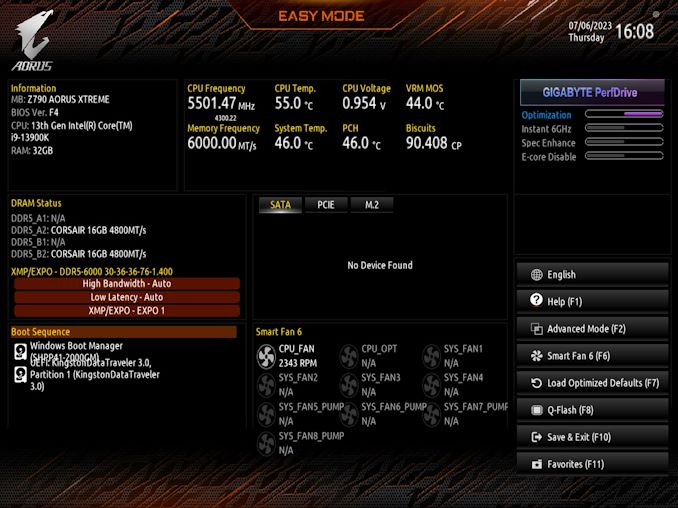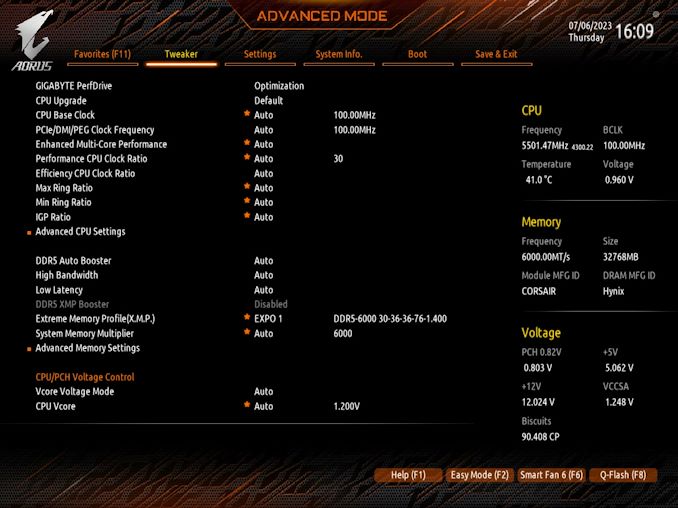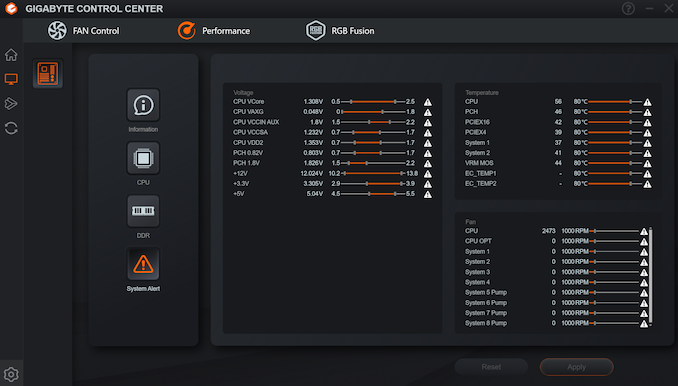GIGABYTE Z790 Aorus Xtreme Motherboard Review: Flagship Z790 With Impressive VRM Thermals
by Gavin Bonshor on September 5, 2023 9:00 AM ESTBIOS
Having seen GIGABYTE's UEFI BIOS many times, the firmware on GIGABYTE Z790 Aorus Xtreme hasn't changed much from previous generations, especially not in terms of the overall theme. The GUI on GIGABYTE's UEFI firmware has Aorus-styled grey and orange highlighting along the top and white text, easily visible on the predominantly black background. Like other vendors, GIGABYTE has two primary BIOS modes for users to select. The first time a user initially boots into the firmware, it brings up the 'easy Mode,' while more advanced users looking to overclock and make other adjustments can press F2 to switch to the 'advanced mode.'
Starting with The 'easy mode' is very similar in functionality to other vendor's implementations, such as ASRock. Cramming quite a lot into one primary splash screen, users can enable XMP or AMD's EXPO profiles on supported memory and change the boot sequence by clicking, dragging, and reordering at will. Users can also access GIGABYTE-specific optimizations, including an Instant 6 GHz profile, disabling E-cores, as well as accessing Smart Fan (F6), Q-Flash (F8), and the advanced mode (F2) by pressing the relevant hotkeys.
Entering the advanced section of the firmware, users looking to overclock their processors will find all the relevant settings within the Tweaker area. The GIGABYTE Z790 Aorus Xtreme is an enthusiast-level flagship so users can customize many CPU voltages, memory latency, power, and integrated graphics settings. GIGABYTE also offers a few profiles for users to overclock the CPU, including a gaming profile and an Instant 6 GHz profile. However, we wouldn't recommend using this unless a user has at least custom water cooling, as Intel's Core i9-13900K does hit thermal limits even on a premium AIO cooler.
Users looking to enable XMP profiles can do so quickly enough, and all of the Intel Z790 boards we've tested so far also support memory with AMD's EXPO profiles. There are extensive memory tweaking options with lots of latency settings, including primary, secondary, and tertiary values, all able to be customized.
Overall, the GIGABYTE UEFI firmware is easy to use and responsive to our USB keyboard and mouse. It has many customizable settings for users to change, and there are plenty of avenues available to increase overall system performance, including extensive memory tweaking options, as well as plenty of options for overclocking both the P and E-cores on Intel's Raptor Lake (13th Gen) and Alder Lake (12th Gen) processors.
Software
Supplied with the Z790 Aorus Xtreme motherboard is a unified software bundle that revolves around the GIGABYTE Control Center application. Acting as a plexus hub for all of GIGABYTE's software utilities, the Control Center includes FAN Control, GIGABYTE's RGB Fusion, and EasyTune, which has now been rebranded as 'Performance' within the utility.
Perhaps the performance section is the most helpful part for enthusiasts within the GIGABYTE Control Center software. This area allows users to overclock their processors within Windows. It has many options available, including CPU core clock ratio modification and many voltage options for users to customize. Users can also modify and set more aggressive power limits and load-line calibration settings.
Overall, GIGABYTE's Control Center is a convenient application, and we like that GIGABYTE has gone for a more uniform solution to streamline all key applications into one place. Users aren't limited to just overclocking, but users can customize the board's RGB LED lighting, as well as sync them across peripherals and compatible chassis fans. Users can create customized fan profiles or go with GIGABYTE's predefined settings.

























22 Comments
View All Comments
duffie - Tuesday, November 21, 2023 - link
Just like most of the articles.PeachNCream - Tuesday, September 5, 2023 - link
At that price, I'm sure there will be several morons that will be proud to display their ignorance by purchasing one.timecop1818 - Wednesday, September 6, 2023 - link
Stopped caring about Gigabyte when they start to include the retarded "Killer" wifi. They can fuck off together with Dell and whoever else sells that shite.Zoolook - Wednesday, September 6, 2023 - link
Who uses Wifi on a desktop with 10Gb, other as an emergency, though I'm with you on the "Killer" wifi feelings in general.Aspernari - Saturday, September 9, 2023 - link
Yeah. Intel Wireless is known to be crap... Wait, no...Killer has been owned by Intel for a few years now.
PeachNCream - Monday, September 11, 2023 - link
The wireless adapters that Killer NICs ultimately use are typically bog standard Intel hardware which is reliable and generally uses decent drivers. That was absolutely not the case before the Intel acquisition, but as you rightfully point out, that isn't a factor.What IS a factor now is the markup for Killer software which is pitched as making your pings lower by giving game packets priority when deciding which to send first. That impacts only the outbound packet traffic and only until it reaches an apathetic home router or your first ISP router where no one gives any priority. So of the potentially hundreds or thousands of miles of cable and dozens of pieces of routing equipment between your PC and a destination, you impact the first 30m or less and only on the outbound side since return trip packets arrive in the order in which they arrive regardless of what a local network adapter might articulate as important. That's the trouble with Killer NICs. There is no actual benefit and no good reason for the branding to continue to exist. At best, its harmless and at worst, the added software layer that processes and pointlessly allocates priority to game traffic is a liability in terms of CPU utilization and added code complexity.
Don't buy into the Ian Cutress baloney. He had a published friendship with ages old Killer personnel and abused his position at Anandtech to boost their products back in 2016. They are not and have never been measurably beneficial to the end user even under Intel's care as they are now.
timecop1818 - Wednesday, September 6, 2023 - link
> As it stands, this is one of the most high-end integrated audio solutions we've seen on a motherboardHmm no mention that ALC4082 is one of those garbage USB audio solutions. I had no idea that was a thing until getting my Asus Z690 mini itx board and finding out that this stuff is indeed trash.
Threska - Wednesday, September 6, 2023 - link
Well it's good enough for beeps and boops, while the real audiophiles are running an external solution via a fiber connection for the purest "0" and "1"'s one can buy.hansmuff - Wednesday, September 6, 2023 - link
That's a very niche audience wanting to have this board, is it not? All that I/O could make for a decent workstation, but then the PCI-E is all messed up just to have those TB connectors. On a workstation I'd want a PCI-E card with 4 or so NVMe SSDs on it and the appropriate throughput.I just find it strange to limit the PCI-E bus for the sake of having all those onboard things. PCI-E lets the user pick what they need and then put it on the bus. All that onboard is great with a real workstation chipset that has endless lanes coming from the CPU, but this....?!??!
Aspernari - Saturday, September 9, 2023 - link
Place the blame on Intel for killing HEDT, and pretty harshly constraining CPU PCIe lanes on desktop/consumer CPUs. Your complaint about onboard components is somewhat moot when there's only a total of 20 CPU lanes to start with, and 16 of those are probably going to a GPU, 4 to an NVMe device, probably through a switch.